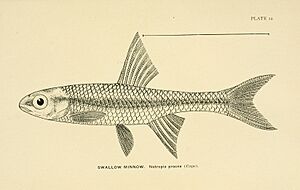Swallowtail shiner facts for kids
The swallowtail shiner (Notropis procne) is a small freshwater fish found in North America. It belongs to the Cyprinidae family, which includes minnows and carps. This fish has a long, slender body, usually growing to about 40 to 55 millimeters (1.6 to 2.2 inches) long.
The swallowtail shiner has a pale yellow back and a shiny silver side with a blue stripe. Its belly is silvery white. Its fins are yellowish, and it has a special black spot at the base of its tail fin. The fish's snout can be a little pointed or slightly rounded. You can find these shiners living in warm creeks and calm river pools.
Quick facts for kids Swallowtail shiner |
|
|---|---|
 |
|
| Drawing of Notropis procne | |
| Conservation status | |
| Scientific classification | |
| Synonyms | |
|
Hybognathus procne Cope, 1865 |
Contents
Where They Live
Swallowtail shiners live in rivers and streams along the Atlantic coast. You can find them from New York all the way down to South Carolina. They might have been brought to the New River system in Virginia, but it's also possible they've always lived there.
Sometimes, these fish can spread through canals into new areas, like the rivers that flow into Lake Ontario. They often like to live near water plants.
What They Eat
The swallowtail shiner is not a picky eater! It enjoys a variety of small foods. Its diet includes tiny insects, worms, mites, and even very small crustaceans (like tiny shrimp). They also eat algae, which are like tiny water plants.
Life Cycle and Reproduction
Young swallowtail shiners grow up quickly. They become adults after about one year. These fish lay their eggs, a process called spawning, from mid-May to July. This happens when the water temperature reaches about 25.6 degrees Celsius (78 degrees Fahrenheit).
The swallowtail shiner is quite similar to its close relatives, the Cape Fear shiner and the sand shiner.
Different Types of Swallowtail Shiners
There are two main types, or subspecies, of the swallowtail shiner. They are called Notropis procne procne and N. procne longiceps.
- The Notropis procne procne type is found in rivers like the Delaware River and Susquehanna River. You can see them as far south as the James River in Virginia.
- The N. procne longiceps type lives further south. They are found from the Roanoke River in Virginia down to the Santee River in South Carolina.


